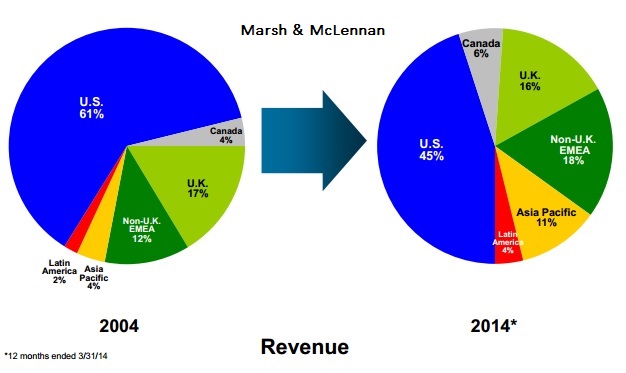For investors looking reap the benefits of the insurance industry without the risk of hurricanes washing away earnings, insurance brokers serve as a more-than-suitable alternative. In fact, over the last three years Aon (AON 0.51%) and Marsh & McLennan (MMC 0.65%) have an impressive 68% and 75% total return, respectively.
The first quarter of 2014 displayed more of the same as Aon, Marsh & McLennan and industry competitor Willis Group (NYSE: WSH) showed strong earnings-per-share growth.
| Company | Q1 2013 | Q1 2014 | Percentage change |
| Aon | $1.11 | $1.28 | 15% |
| Marsh & McLennan | $0.74 | $0.80 | 9% |
| Willis Group | $1.24 | $1.35 | 8% |
Source: Company filings.
While earnings growth is nice, to truly understand these businesses you have to go beyond the bottom line. Here are three key takeaways from Aon, Marsh & McLennan, and Willis Group's first quarter.
3. Tax rates
Rarely, if ever, do I take notice of a company's tax rate. However, when adjusting for taxes, year-over-year earnings look much different than the double-digit growth picture Aon painted for shareholders.
| Company | Q1 2013 | Q1 2014 | Percentage change |
| Aon | $496 | $500 | 0.8% |
| Marsh & McLennan | $588 | $649 | 10.4% |
| Willis Group | $271 | $313 | 15.5% |
Aon benefited from a huge tax cut (from 26% in the first quarter of 2013 to 19%) in 2014. The company suggested that the favorable tax rate had to do with its geographic distribution of income. CFO Crista Davies noted that this tax rate will likely increase over the course of the year, but not above last years rate of 26%.
Bear in mind that as of the first quarter of 2014 the smaller Willis Group and Mash & McLennan have effective tax rates of approximately 20% and 30%, respectively.
2. Growth opportunities
While each company has its own unique growth opportunities, all three share emerging market growth as a key driver. Willis Group's CEO Dominic Casserely suggested, "We continued to invest in higher growth regions such as emerging markets." The investment seemed to pay off as "International" was the company's fastest-growing segment at 5.7% year-over-year.
Aon saw double-digit new business growth "across Latin America, Asia, and the EMEA (Europe, Middle East, and Africa) region." Marsh & McLennan, similarly, has continued to see strong growth outside the U.S. In fact, over the last decade significantly less of the company's revenue is coming from the U.S. This is a trend you should expect to continue.

Source: Marsh & McLennan investor presentation.
1. Putting cash to work
Perhaps the most important theme in the first quarter was centered around cost cutting strategies. For example, Aon suggested operational improvements, restructuring and pension costs being wound down, and the company's lower tax rate, should lead to generating $2.3 billion in annual free cash flow (operating cash flow minus capital expenditures). If the plan is successful it would double Aon's free cash flow in the next three to five years.
While Marsh & McLennan and Willis Group have similar plans, whether or not these companies are able to follow through is a question for another day. What I can say, though, is all three companies have been putting what cash they do have to work.
Aon, Marsh & McLennan, and Willis Group repurchased $600 million, $100 million, and $200 million in shares, respectively.
Aon expects to continue share buybacks throughout the year, though perhaps not at the same rate as the first quarter. Marsh & McLennan, similarly, hopes to have $2.1 billion in capital to put toward dividends, share repurchase, and acquisitions in 2014.
The last word
Overall it was a solid first quarter for Aon, Marsh & McLennan, and Willis Group. These companies' global presence, scale advantage, and industry insight puts all three companies in the unique position to serve some of today's largest businesses.
Investors should keep in mind that one quarter isn't necessarily a representative sample of what the year will hold. However, as we progress further into 2014 investors should be watching for cost cutting strategies and how cash is being utilized to create shareholder value.
